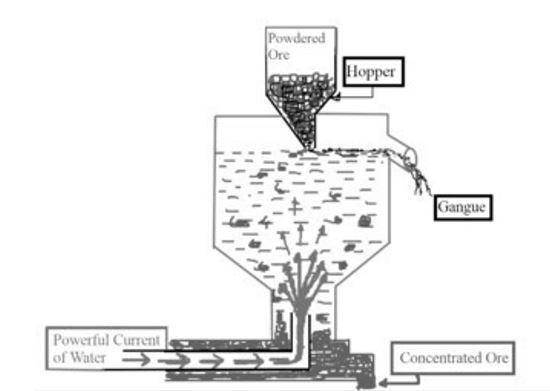
Write the principle behind the following methods of refining:
A.Hydraulic washing
B.Vapour-phase refining
Answer
510.3k+ views
Hint: In hydraulic washing the ore is passed in an upward stream of water which separates the lighter gangue particles from the heavier ore particles.
In vapour phase refining metal is converted into a volatile form which is then decomposed to give pure metal.
Complete step by step answer:
Hydraulic washing
In hydraulic washing, ore is first powdered and is then washed in a stream of water flowing in upward direction. As the gangue particles are lighter, they get washed away while the heavier ore remains back. Hydraulic washing is also known as gravity separation method. It makes use of the difference in the effect of gravity on gangue and on ore. The ore is poured over a hydraulic classifier and a powerful water current is allowed to flow. Due to differences in effect of gravity, the denser ore settles and the gangue is washed away. This method is generally used for concentrating ores which exist as heavy oxides. E.g. lead, tin and iron.

Vapour phase refining is a type of purification of the extracted metal. In this method, the metal forms a volatile compound in presence of a reagent. This volatile compound then undergoes decomposition in order to give pure metal. It is based on the principle that impure metal when converted into a volatile compound can be collected elsewhere. Later, it can be decomposed to give pure metal. Nickel, Zirconium and titanium are refined using this method.
Note: The disadvantage of hydraulic washing, is that the ore and gangue must have a difference in weight. This method cannot be used for ores which have gangue of similar weight.
The disadvantage of vapour phase refining is the metal must be easily converted to a volatile form and should be easy to recover on decomposition. Otherwise, this method cannot be used.
In vapour phase refining metal is converted into a volatile form which is then decomposed to give pure metal.
Complete step by step answer:
Hydraulic washing
In hydraulic washing, ore is first powdered and is then washed in a stream of water flowing in upward direction. As the gangue particles are lighter, they get washed away while the heavier ore remains back. Hydraulic washing is also known as gravity separation method. It makes use of the difference in the effect of gravity on gangue and on ore. The ore is poured over a hydraulic classifier and a powerful water current is allowed to flow. Due to differences in effect of gravity, the denser ore settles and the gangue is washed away. This method is generally used for concentrating ores which exist as heavy oxides. E.g. lead, tin and iron.

Vapour-phase refining
Vapour phase refining is a type of purification of the extracted metal. In this method, the metal forms a volatile compound in presence of a reagent. This volatile compound then undergoes decomposition in order to give pure metal. It is based on the principle that impure metal when converted into a volatile compound can be collected elsewhere. Later, it can be decomposed to give pure metal. Nickel, Zirconium and titanium are refined using this method.
Note: The disadvantage of hydraulic washing, is that the ore and gangue must have a difference in weight. This method cannot be used for ores which have gangue of similar weight.
The disadvantage of vapour phase refining is the metal must be easily converted to a volatile form and should be easy to recover on decomposition. Otherwise, this method cannot be used.
Recently Updated Pages
Master Class 11 Economics: Engaging Questions & Answers for Success

Master Class 11 Business Studies: Engaging Questions & Answers for Success

Master Class 11 Accountancy: Engaging Questions & Answers for Success

Master Class 11 English: Engaging Questions & Answers for Success

Master Class 11 Computer Science: Engaging Questions & Answers for Success

Master Class 11 Maths: Engaging Questions & Answers for Success

Trending doubts
State and prove Bernoullis theorem class 11 physics CBSE

1 ton equals to A 100 kg B 1000 kg C 10 kg D 10000 class 11 physics CBSE

State the laws of reflection of light

One Metric ton is equal to kg A 10000 B 1000 C 100 class 11 physics CBSE

Difference Between Prokaryotic Cells and Eukaryotic Cells

1 Quintal is equal to a 110 kg b 10 kg c 100kg d 1000 class 11 physics CBSE




